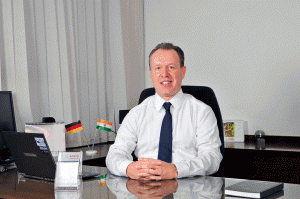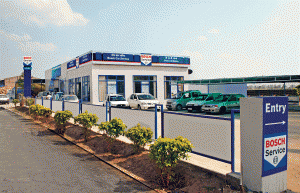Text: T Murrali
The aftermarket in India is not too different from those in developed countries, having OEM specific workshops and multi-brand workshops. However, unlike the developed markets that follow a multiple approach, servicing all kinds’ of vehicles – 2/3 wheelers, cars and commercial vehicles under one roof – aftermarket in India follows a specific approach. Besides, India has a big challenge because vehicles with new and old technologies co-exist, creating complexity from a product and knowledge perspective. However, there are opportunities in these challenges because India will be able to adapt to changes, says the Regional President – Automotive Aftermarket, Bosch Limited, Guenter Weber.
 Speaking to Auto Components India, Weber states, as a manufacturer, the company’s task is to support the technicians and the market to get into this direction. It follows a 3-pillar approach; parts for OE development, the test equipment – diagnostic tools, test benches, machine testers etc – and thirdly, the knowledge of services encompassing training of technicians to repair vehicles. These pillars are bolstered by its helpline.
Speaking to Auto Components India, Weber states, as a manufacturer, the company’s task is to support the technicians and the market to get into this direction. It follows a 3-pillar approach; parts for OE development, the test equipment – diagnostic tools, test benches, machine testers etc – and thirdly, the knowledge of services encompassing training of technicians to repair vehicles. These pillars are bolstered by its helpline.
Diagnostics
Diagnostics is the core but if this does not solve the problem then it is necessary to take other steps to solve it. “This is what we have integrated in our software, a guided trouble-shooting which helps the technician to step by step identify the problem and address it. That’s where our training helps. With the amount of new technology vehicles coming into India, the demand is increasing for technicians getting trained in the right way. So we are getting more requests for our diagnostics training. Compared to the OEMs training, our training is multi-brand, developed to handle multiple trainers. This is what we are seeing in India – that shops are being established to handle multi-brands,” he says.
Slowdown
According to Weber, there was huge increase in India in the number of vehicles over previous years; now it’s growing even in a crisis, but not as much. Trucks are the exemption since not many goods are being transported when the industry is slowing down, eventually affecting the spare parts market. Some segments are slowing down a little bit more than others, but still a few segments grow. Is better technology affecting the aftermarket as the life of the components is increasing? Weber says, “Yes and no; yes, because better quality, which is good for the end-consumer, normally would reduce the aftermarket. On the other side, India is growing so much with additional vehicles that there are more vehicles on the road now. So this results in the aftermarket still growing.”
Weber, who has served in many developed markets, observes that a similar phenomenon can be seen in the US and other markets; however, it is necessary to consider the driving behaviour and the environment. For instance, driving in a city where there is smog will make the vehicle behave differently. Therefore, there are multiple points that influence the market volume of the automotive sector. However, he is confident about the earlier recovery of the aftermarket in India since, “all the indicators at the moment are showing that we are coming back into growth. What I have seen after the general election is that the confidence in the market is coming back. The most critical part at the moment is liquidity, which is vital for the aftermarket.”
We, the Individuals . . .
Alarmingly, aftermarket representatives lament the lack of industry status hampering prospects of getting funds at competitive interest rates. However, Weber has a different point of view. He says it is because of “We, the end-consumers.” Lack of faith in the economy steers them to postpone impending vehicle service. On the other hand if they spend money, it catalyses the funds flow, eventually enabling the aftermarket to get its due. So it starts with the end-consumer which is where the liquidity is. “If you and I spend then it’s a good thing for the aftermarket,” he reiterates.
According to published reports, close to 80% of the aftermarket accounts for spare parts and the rest for services. Weber observes that the share of services will increase due to increasing labour costs. Better technology or electronics will increase the life of components but the issue will arise due to accidents. Since it is getting more sensitive, the need to invest in diagnostic components and the systems increase.
Best Practice
Though he did not put a number to it, Weber says the aftermarket for Bosch Limited was good. “Overall our development was good and we have not gone through a slump,” he says. On the cross pollination of ideas from different markets, he says that being a large company, Bosch can take the knowledge from different markets and transfer this easily to India.
 Weber says there are 3 focus areas going forward; one is the products that come from its OE divisions and those developed in-house. The second is the test equipment business where the company sees significant potential for further growth because there is a need to bring test equipment into the workshops in India based on new technologies. The third is setting up of distribution centres as the market is shifting to rural areas. The company is increasing its footprint deeper into the market. Sensing the need for qualified workshops in India it is planning to focus on workshops – Bosch Car Service, Express Bike Service and its network of Diesel workshops. Currently, the company has more than 3,000 shops working with their logo and brand name in India including nearly 600 Bosch Car Service and 350 Express Bike Service centres.
Weber says there are 3 focus areas going forward; one is the products that come from its OE divisions and those developed in-house. The second is the test equipment business where the company sees significant potential for further growth because there is a need to bring test equipment into the workshops in India based on new technologies. The third is setting up of distribution centres as the market is shifting to rural areas. The company is increasing its footprint deeper into the market. Sensing the need for qualified workshops in India it is planning to focus on workshops – Bosch Car Service, Express Bike Service and its network of Diesel workshops. Currently, the company has more than 3,000 shops working with their logo and brand name in India including nearly 600 Bosch Car Service and 350 Express Bike Service centres.
Asked about introduction of new products, he said the aftermarket division follows its counterpart, catering to OEMs. “We have 10 business areas including diesel/gasoline systems, wiper blades, spark plugs, braking, filtration, lube oils etc. Our aim is to provide high market coverage for the independent aftermarket by continuously bringing in new products,” he adds. In the case of test equipment, the focus is on diagnostic components, equipment for ‘around the wheel’ that comprises of tyre changers, wheel balancers, wheel alignment etc. Besides, it will concentrate on air-conditioning. “We have to watch how the market is developing, depending on the regulations in India. We have the emission tester and braking tests and we can bring these to the market if we see the need in India.”
Re-manufacturing
What a lot of companies claim as re-manufacturing is only a repair job, says Weber. Re-manufacturing, according to him, is a standardised process in reworking existing products in a systematic industrial process. The US market is clear on re-manufacturing, reconditioning and repair work and in Europe the industry tries to establish the same. In India, so far everybody tries to talk about re-manufacturing. At the moment Bosch is not looking at this segment of business because India is still a repair market due to price sensitivity. The impediments are the cost of labour, lack of dedicated logistics and the supply chain system, which is not going into the market but has to go in reverse to the market; and there should be a system to get the products back. Elaborating this concept, he says, in the US as well as in Europe, markets have products and the customers pay an additional value for it; this is because of the logistic system that brings the products into the market, collects the money for its core value, and pays back while receiving the old product. Bosch in India had tried this concept in starters some time ago but this has since been discontinued.











